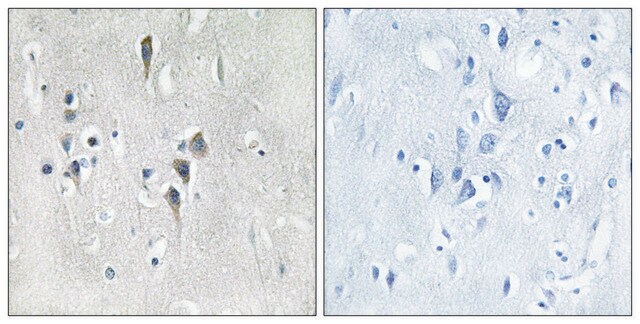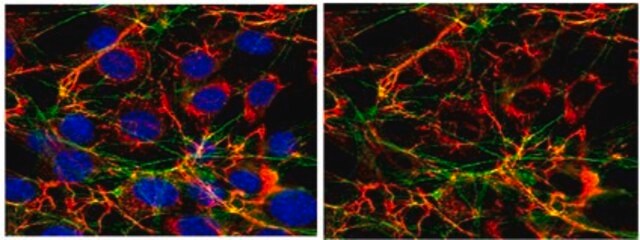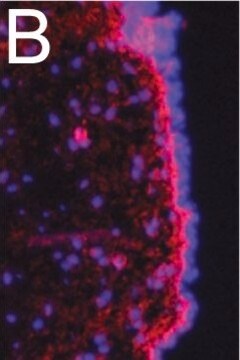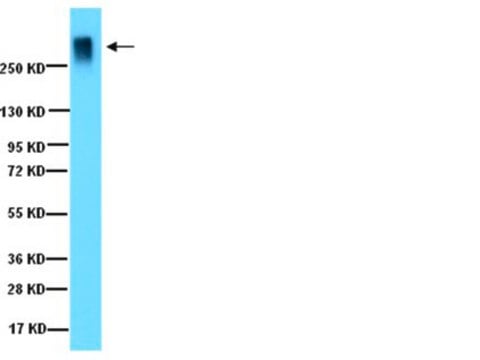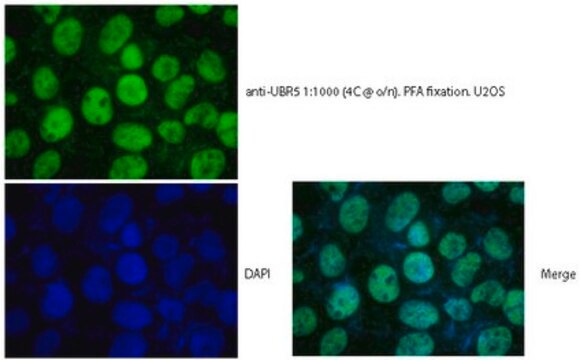AB2047
Anti-Fibronectin Antibody
Chemicon®, from rabbit
About This Item
Recommended Products
biological source
rabbit
antibody form
affinity purified immunoglobulin
antibody product type
primary antibodies
clone
polyclonal
species reactivity
bovine
manufacturer/tradename
Chemicon®
technique(s)
ELISA: suitable
immunofluorescence: suitable
immunohistochemistry: suitable (paraffin)
radioimmunoassay: suitable
western blot: suitable
UniProt accession no.
shipped in
dry ice
target post-translational modification
unmodified
General description
Fibronectin exists in two main forms: 1) as an insoluble glycoprotein dimer that serves as a linker in the ECM (extracellular matrix), and; 2) as a soluble disulphide linked dimer found in the plasma (plasma FN). The plasma form is synthesized by hepatocytes, and the ECM form is made by fibroblasts, chondrocytes, endothelial cells, macrophages, as well as certain epithelial cells.
Fibronectin sometimes serves as a general cell adhesion molecule by anchoring cells to collagen or proteoglycan substrates. FN also can serve to organize cellular interaction with the ECM by binding to different components of the extracellular matrix and to membrane-bound FN receptors on cell surfaces. The importance of fibronectin in cell migration events during embryogenesis has been documented in several contexts, e.g.: 1) mesodermal cell migration during gastrulation can be blocked by injection of Arg-Gly-Asp (RGD) tripeptides that block cellular FN receptors (integrins); 2) injection of anti-FN antibodies into chick embryos blocks migration of precardiac cells to the embryonic midline, and; 3) the patterns of FN deposition in developing vertebrate limbs determines the patterns of precartilage cell adhesion to the ECM, thereby specifying limb-specific patterns of chondrogenesis. {D. Marcey, http://www.clunet.edu/BioDev/omm/fibro/frames/fibrotxt.htm}.
Specificity
Immunogen
Application
Immunohistochemistry on paraffin embedded tissues requires light fixation in 2% PFA, 4% formalin (less than 90 minutes), acetone or methyl-carnoy fixation; traditional formalin fixation is not recommended. Antigen retrieval is HIER citrate buffer; detection is via enhanced enzymatic methods only.
Immunoblotting: 1:1000 of 2% deoxycholate + 10% SDS, 6M urea extracted bovine cell cultures (Kinsella, 2000). Antibody demonstates the appropriate twin bands at ~220kDa.
Radioimmunoassay
ELISA
Optimal working dilutions must be determined by end user.
Cell Structure
ECM Proteins
Physical form
Storage and Stability
Other Notes
Legal Information
Disclaimer
Not finding the right product?
Try our Product Selector Tool.
Storage Class Code
12 - Non Combustible Liquids
WGK
WGK 2
Flash Point(F)
Not applicable
Flash Point(C)
Not applicable
Certificates of Analysis (COA)
Search for Certificates of Analysis (COA) by entering the products Lot/Batch Number. Lot and Batch Numbers can be found on a product’s label following the words ‘Lot’ or ‘Batch’.
Already Own This Product?
Find documentation for the products that you have recently purchased in the Document Library.
Our team of scientists has experience in all areas of research including Life Science, Material Science, Chemical Synthesis, Chromatography, Analytical and many others.
Contact Technical Service